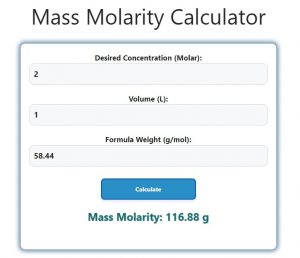About Mass Molarity Calculator (Formula)
A mass molarity calculator is a valuable tool in chemistry for determining how much solute is required to achieve a desired molarity in a solution. Understanding molarity—the number of moles of solute per liter of solution—is essential for accurate preparations in labs and various applications in science and industry. This article will explain the formula used, how to use the calculator, provide an example, and answer frequently asked questions.
Formula
The formula for calculating the mass of a solute needed for a solution is:
M = C × V × W,
where M is the mass of the solute in grams, C is the desired molarity in moles per liter, V is the volume of the solution in liters, and W is the molar mass of the solute in grams per mole.
How to Use
Using a mass molarity calculator involves the following steps:
- Determine Molarity (C): Decide the desired molarity of the solution.
- Measure Volume (V): Measure the volume of the solution in liters.
- Know Molar Mass (W): Obtain the molar mass of the solute from a periodic table or chemical reference.
- Input Values: Enter the values for molarity, volume, and molar mass into the calculator.
- Calculate Mass: The calculator will compute the mass of the solute required for the specified conditions.
Example
Let’s say you want to prepare a 2 M (molar) solution of sodium chloride (NaCl) in a total volume of 1 liter. The molar mass of NaCl is approximately 58.44 g/mol.
- Desired Molarity (C): 2 M
- Volume of Solution (V): 1 L
- Molar Mass of NaCl (W): 58.44 g/mol
Now, plug the values into the formula:
M = C × V × W
M = 2 M × 1 L × 58.44 g/mol = 116.88 g
Therefore, you would need approximately 116.88 grams of NaCl to prepare a 2 M solution.

FAQs
1. What is molarity?
Molarity is a measure of concentration expressed as the number of moles of solute per liter of solution.
2. How do I find the molar mass of a compound?
The molar mass can be found using a periodic table, where you sum the atomic masses of all the elements in the compound.
3. Why is knowing the mass of solute important?
Knowing the mass of solute is crucial for preparing solutions accurately for experiments or reactions.
4. Can I use this calculator for any solute?
Yes, you can use the mass molarity calculator for any solute as long as you know its molar mass.
5. What units are used for volume in this calculation?
Volume should be measured in liters for the calculation to work correctly.
6. How do I convert milliliters to liters?
To convert milliliters to liters, divide the number of milliliters by 1000. For example, 500 mL = 0.5 L.
7. What happens if I don’t measure accurately?
Inaccurate measurements can lead to incorrect molarity, which may affect the outcome of experiments.
8. Can I use this calculator for dilutions?
Yes, you can adapt the calculator to determine how much solute to add for diluting a more concentrated solution.
9. Is it necessary to use a calculator?
While you can do the calculations manually, a calculator simplifies the process and reduces the chance of error.
10. What are some common uses for molarity calculations?
Molarity calculations are commonly used in chemistry labs, pharmaceuticals, and when preparing solutions for various chemical reactions.
11. Can this calculator help with titrations?
Yes, knowing the molarity of solutions used in titrations is essential for determining the concentrations of unknown solutions.
12. What if I only have the mass of the solute?
If you have the mass, you can calculate the molarity by rearranging the formula to find C = M / (V × W).
13. How does temperature affect molarity?
Temperature can affect the volume of the solution, so it’s important to conduct measurements at a consistent temperature for accurate results.
14. Are there online mass molarity calculators available?
Yes, many online tools can assist with mass molarity calculations by allowing you to input values directly.
15. Can I use this method for gases?
While the principle is similar, gas solubility in liquids can complicate molarity calculations; specific conditions may need to be considered.
16. What if I need a very dilute solution?
You can still use the calculator for dilute solutions; just input the desired molarity, which can be less than 1 M.
17. How do I ensure safety when handling chemicals?
Always wear appropriate personal protective equipment (PPE) such as gloves, goggles, and a lab coat when handling chemicals.
18. Can I mix different solutes in one solution?
Yes, but you will need to calculate the total molarity based on the amounts and molar masses of each solute.
19. What is the difference between molarity and molality?
Molarity is based on the volume of the solution, while molality is based on the mass of the solvent.
20. How often should I recalibrate my equipment?
It’s good practice to recalibrate measuring equipment regularly to ensure accuracy, especially in a laboratory setting.
Conclusion
A mass molarity calculator is an essential tool for anyone working in chemistry or related fields. By understanding the formula and how to use it, you can accurately prepare solutions, ensuring the correct concentration of solute. This knowledge not only aids in scientific experiments but also enhances efficiency in various applications. Whether you’re a student or a professional, mastering this tool will significantly improve your lab skills.